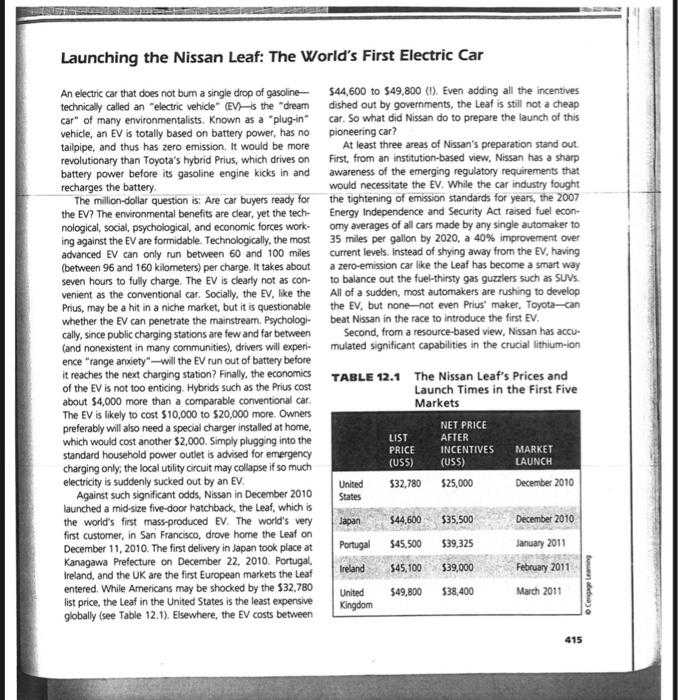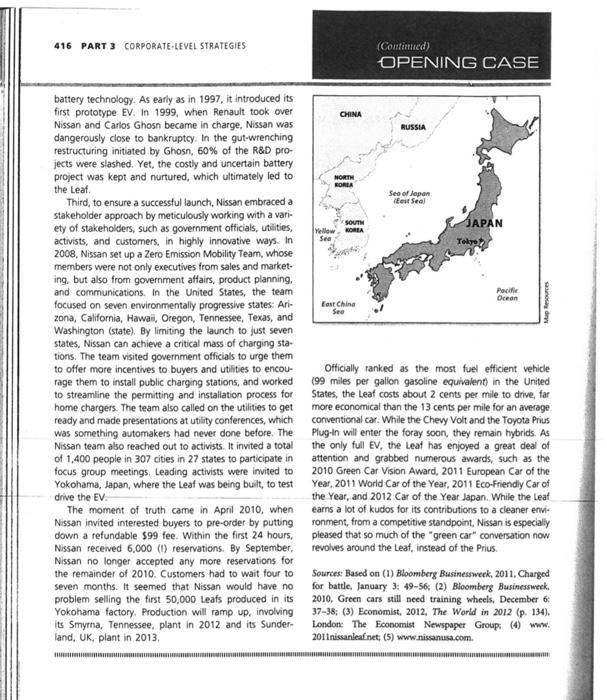Describe what is corporate social responsibility, Next, describe the type of corporate social responsibility of this firm on the production side.

Launching the Nissan Leaf: The World's First Electric Car An electric car that does not bum a single drop of gasoline- $44,600 to $49,800 (1). Even adding all the incentives technicaly called an "electric vehicle" (EV)-is the "dream dished out by governments, the Leat is still not a cheap car" of many environmentalists. Known as a "plug-in" car. So what did Nissan do to prepare the launch of this vehicle, an EV is totally based on battery power, has no pioneering car? tailpipe, and thus has zero emission, It would be more At least three areas of Nissan's preparation stand out. revolutionary than Toyota's hybrid Prius, which drives on First, from an instutution-based view, Nissan has a sharp battery power before its gasoline engine kicks in and awareness of the emerging regulatory requirements that recharges the battery. would necessitate the EV. While the car industry fought The million-dollar question is. Are car buyers ready for the tightening of emission standards for years, the 2007 the EV? The environmental benefits are clear, yet the tech- Energy Independence and Security Act raised fuel econnological, social, psychological, and economic forces work- omy averages of all cars made by any single automaker to ing against the EVare formidable. Technologically, the most 35 miles per gallon by 2020, a 40% improvement over advanced EV can only run between 60 and 100 miles current levels. Instead of shying away from the EV, having (between 96 and 160 kilometers) per charge. It takes about a zero-emission car like the Leaf has become a smart way seven hours to fully charge. The EV is clearly not as con- to balance out the fuel-thirsty gas guzzlers such as SuVs. venient as the conventional car. Socially, the EV, ike the All of a sudden, most automakers are rushing to develop Prius, may be a hit in a niche market, but it is questionable the EV, but none-not even Prius' maker, Toyota-can whether the EV can penetrate the mainstream. Psychologi- beat Nissan in the race to introduce the first EV. cally, since public charging stations are few and far between Second, from a resource-based view, Nissan has accu(and nonexistent in many communities), drivers will experi- mulated significant capablitities in the crucial lithium-ion ence "range anxiety" -will the EV run out of battery before it reaches the next charging station? Finally, the economics TABLE 12.1 The Nissan Leaf's Prices and of the EV is not too enticing. Hybrids such as the Prius cost Launch Times in the First Five about $4,000 more than a comparable conventional car. Markets The EV is likely to cost $10,000 to $20,000 more. Owners preferably will also need a special charger installed at home. which would cost another $2,000. Simply plugging into the standard household power outlet is advised for emergency charging only; the local utitity circuit may collapse if so much electricity is suddenly sucked out by an EV. Agairst such significant odds, Nissan in December 2010 launched a mid-size five-door hatchback, the Leaf, which is the world's first mass-produced EV. The world's very first customer, in San Francisco, drove home the Leaf on December 11,2010 . The first delivery in Japan took place at Kanagawa Prefecture on December 22, 2010. Portugal. Ireland, and the UK are the first European markets the Leaf entered. While Americans may be shocked by the $32,780 list price, the Leaf in the United States is the least expensive globally (see Table 12.1). Elsewhere, the EV costs between battery technology. As early as in 1997, it introduced its first prototype EV. In 1999, when Renault took over Nissan and Carlos Ghosn became in charge, Nissan was dangerously close to bankruptcy. In the gut-wrenching restructuring initiated by Ghosn, 60% of the R\&D projects were slashed. Yet, the costly and uncertain battery project was kept and nurtured, which ultimately led to the Leaf. Third, to ensure a successtul launch, Nissan embraced a stakeholder approach by meticulously working with a variety of stakeholders, such as government officials, utlities, activists, and customers, in highly innovative ways. In 2008, Nissan set up a Zero Emission Mobility Team, whose members were not only executives from sales and marketing. but also from government affairs, product planning, and communications. In the United States, the team focused on seven environmentally progressive states: Arizona, California, Hawai, Oregon, Tennessee, Texas, and Washington (state). By limiting the launch to just seven states, Nissan can achieve a critical mass of charging stations. The team visited government officials to urge them to offer more incentives to buyers and utilities to encou- Officially ranked as the most fuel efficient vehicle rage them to install public charging stations, and worked 99 miles per galion gasoline equivalent) in the United to streamline the permitting and installation process for States, the Leaf costs about 2 cents per mile to drive, far home chargers. The team also called on the utilities to get more economical than the 13 cents per mile for an average ready and made presentations at utility conferences, which conventional car. While the Chevy Volt and the Toyota Prius was something automakers had never done before. The Plug-in will enter the foray soon, they remain hybrids. As Nissan team also reached out to activists. It invited a total the only full EV, the Leat has enjoyed a great deal of of 1,400 people in 307 cities in 27 states to participate in attention and grabbed numerous awards, such as the focus group meetings. Leading activists were invited to 2010 Green Car Vision Award, 2011 European Car of the Yokohama, Japan, where the Leaf was being bulit, to test Year, 2011 Worid Car of the Year, 2011 Eco-friendly Car of drive the EV. the Year, and 2012 Car of the Year Japan. While the Leat The moment of truth came in April 2010, when earns a lot of kudos for its contributions to a cleaner enviNissan invited interested buyers to pre-order by putting ronment, from a competitive standpoint, Nissan is especially down a refundable $99 fee. Within the first 24 hours, pleased that so much of the "green car" conversation now Nissan received 6,000 (I) reservations. By September, revolves around the Leat, instead of the Prius. Nissan no longer accepted any more reservations for the remainder of 2010. Customers had to wait four to Souress Based on (1) Bloomberg Businessweek, 2011, Charged seven months. It seemed that Nissan would have no for battle, January 3: 49-56: (2) Bloomberg Businessweek, problem selling the first 50,000 Leafs produced in its 2010, Green cars still need training wheels, December 6 : Yokohama factory. Production will ramp up, involving 37-38; (3) Economist, 2012, The World in 2012 (p. 134), its Smyrna, Tennessee, plant in 2012 and its Sunder- London. The Economist Newspaper Group (4) ww. land, UK, plant in 2013. 2011nissanleaf net (5) www nissanusacom








